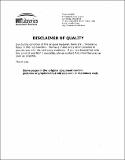| dc.contributor.advisor | John E. Keesee. | en_US |
| dc.contributor.author | Parness, Aaron J. (Aaron Joseph), 1981- | en_US |
| dc.contributor.other | Massachusetts Institute of Technology. Dept. of Mechanical Engineering. | en_US |
| dc.date.accessioned | 2006-05-15T20:29:02Z | |
| dc.date.available | 2006-05-15T20:29:02Z | |
| dc.date.copyright | 2004 | en_US |
| dc.date.issued | 2004 | en_US |
| dc.identifier.uri | http://hdl.handle.net/1721.1/32774 | |
| dc.description | Thesis (S.B.)--Massachusetts Institute of Technology, Dept. of Mechanical Engineering, 2004. | en_US |
| dc.description | Includes bibliographical references. | en_US |
| dc.description.abstract | An experiment was conducted to help compare possible cooling methods for the payload module of the Mars Gravity Biosatellite. The Satellite will be launched into space with 15 mice on board and rotated to create a 0.38g centrifugal acceleration, the acceleration due to gravity on Mars. The mission will last 5 weeks and take valuable data on mammal's responses to extended periods of time in reduced gravity. Because of a large heat shield needed for reentering the Earth's atmosphere, the payload module is nearly perfectly insulated. It is therefore necessary to actively transport heat out of the capsule and radiate it off into space. A thermal electric cooler and a heat sink and fan combination were compared in this experiment for that purpose, using a Styrofoam cooler as a model payload. It was found that the fan and heat sink combination was more efficient than the thermal electric cooler. The coefficient of performances of the respective cooling elements was found to be 5.89 for the fan and heat sink while only 1.67 for the thermal electric cooler. However, it was also observed that the thermal electric cooler, while less efficient, could transport much more heat than the fan and heat sink alone, 26.4 Watts compared to 9.73 Watts in the experimental set up. It has been recommended that a combination of a fan and heat sink be used in the payload module of the satellite. | en_US |
| dc.description.statementofresponsibility | by Aaron J. Parness. | en_US |
| dc.format.extent | 37 leaves | en_US |
| dc.format.extent | 2710645 bytes | |
| dc.format.extent | 2710139 bytes | |
| dc.format.mimetype | application/pdf | |
| dc.format.mimetype | application/pdf | |
| dc.language.iso | eng | en_US |
| dc.publisher | Massachusetts Institute of Technology | en_US |
| dc.rights | M.I.T. theses are protected by copyright. They may be viewed from this source for any purpose, but reproduction or distribution in any format is prohibited without written permission. See provided URL for inquiries about permission. | en_US |
| dc.rights.uri | http://dspace.mit.edu/handle/1721.1/7582 | |
| dc.subject | Mechanical Engineering. | en_US |
| dc.title | Comparison of heat sink and fan combinations and thermal electric coolers for use in the Mars Gravity Biosatellite | en_US |
| dc.type | Thesis | en_US |
| dc.description.degree | S.B. | en_US |
| dc.contributor.department | Massachusetts Institute of Technology. Department of Mechanical Engineering | |
| dc.identifier.oclc | 57570828 | en_US |
